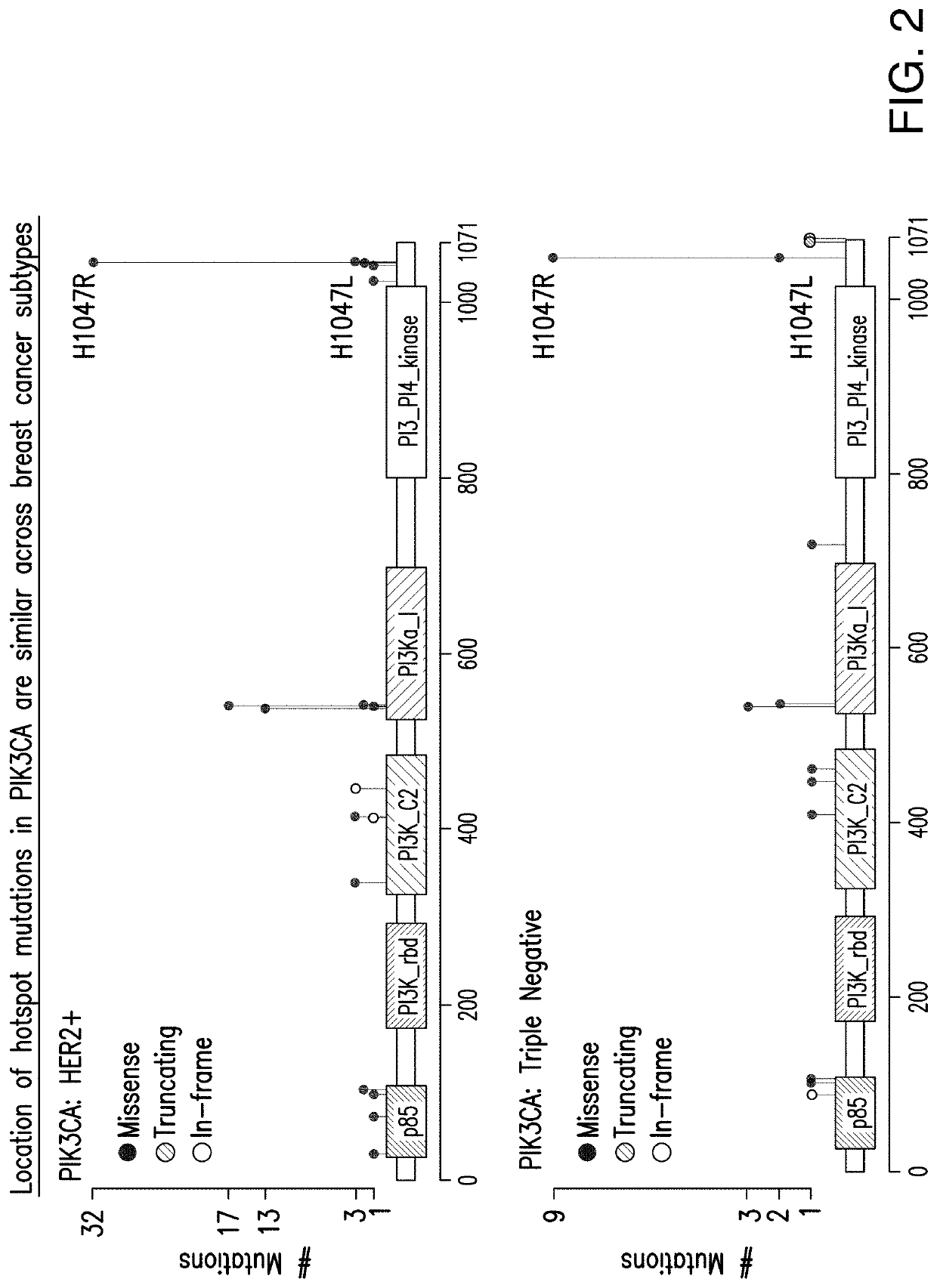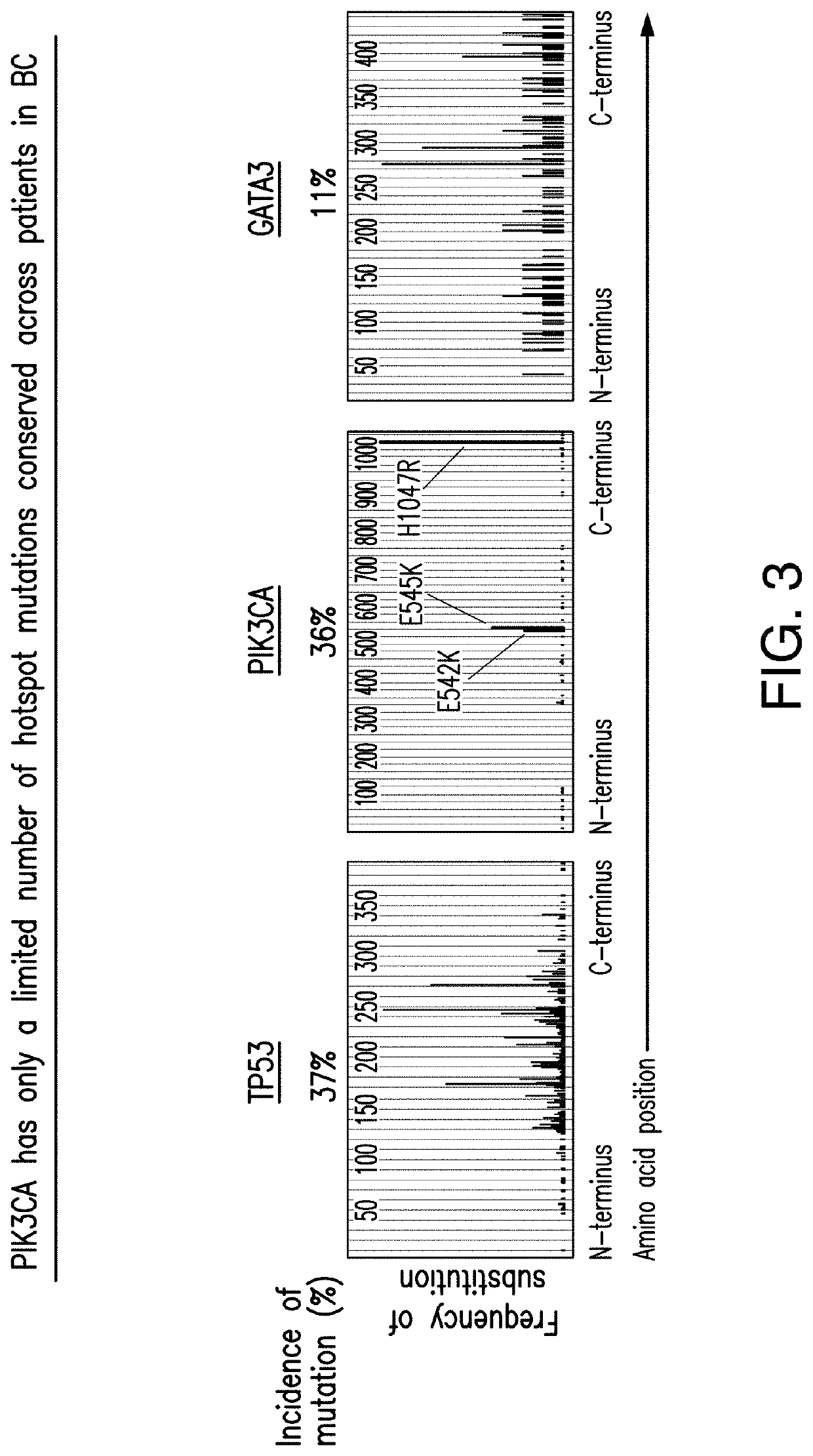T cell receptors targeting pik3ca mutations and uses thereof
a technology of t cell receptors and mutations, applied in the direction of animal/human proteins, chemical apparatus and processes, drug compositions, etc., can solve the problem that pik3ca only has a limited number of hotspot mutations, and achieve the effect of reducing or eliminating the tumor burden in the subj
- Summary
- Abstract
- Description
- Claims
- Application Information
AI Technical Summary
Benefits of technology
Problems solved by technology
Method used
Image
Examples
example 1
n of Mutant PIK3CA-Targeted TCRs
[0305]Previous study demonstrated that a third of breast cancers have PIK3CA mutations. Millis et al., JAMA Oncol. 2016; 2(12):1565-1573. The mutations were more common in HR+ breast cancer (40-80%) and were sufficient to drive breast cancer in cells and animals. FIG. 1 shows the frequency and location of PIK3CA mutations in 1,501 MSKCC HR+ / HER2− breast cancer patients, where H1047L / R mutation accounted of 35% of the cases. As shown in FIG. 2, the location of hotspot mutations in PIK3CA were similar across breast cancer subtypes. As shown in FIG. 3, PIK3CA has only a limited number of hotspot mutations conserved across patients in breast cancer. These features made targeting specific mutations of PIK3CA a promising strategy for targeting and eliminating breast cancer cells.
[0306]To identify TCRs specifically targeting mutant PIK3CA, peripheral blood mononuclear cells (PBMCs) from healthy donors were stimulated with autologous mature antigen-presenting...
example 2
ion of PIK3CA-Targeted TCR, LB11-2
[0321]This example further characterizes mutant PIK3CA-targeted TCR, LB11-2. As shown in FIG. 24, mutation-specific reactivity of TCRs identified via VDJ sequencing from well LB11 were further tested. The genetic sequences encoding the alpha and beta chains of mutation-specific TCR derived from VDJ sequencing were cloned into a retroviral vector and stably integrated into allogeneic donor cells. The 3 unique TCR sequences tested were LB11-2, LB11-3 and LB11-4. TCR-transduced cells were cocultured with autologous dendritic cells (DC) that had been transiently transfected with RNA encoding either wildtype or mutant PIK3CA. Reactivity was determined by observing the production of the degranulation marker, CD107A, (upper panels) or the inflammatory cytokine, TNF-α, (lower panels) in response to the DC expressing mutated PIK3CA. LB11-2 was the only mutation-specific TCR identified within this set.
[0322]Similarly, FIG. 25 shows testing of mutation-specifi...
PUM
| Property | Measurement | Unit |
|---|---|---|
| temperatures | aaaaa | aaaaa |
| temperatures | aaaaa | aaaaa |
| temperatures | aaaaa | aaaaa |
Abstract
Description
Claims
Application Information
 Login to View More
Login to View More - R&D
- Intellectual Property
- Life Sciences
- Materials
- Tech Scout
- Unparalleled Data Quality
- Higher Quality Content
- 60% Fewer Hallucinations
Browse by: Latest US Patents, China's latest patents, Technical Efficacy Thesaurus, Application Domain, Technology Topic, Popular Technical Reports.
© 2025 PatSnap. All rights reserved.Legal|Privacy policy|Modern Slavery Act Transparency Statement|Sitemap|About US| Contact US: help@patsnap.com



